#central eastern europe
Explore tagged Tumblr posts
Text
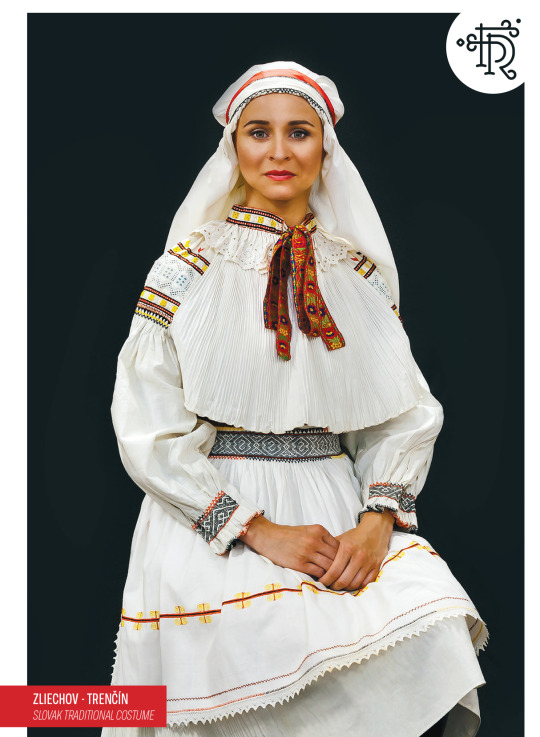
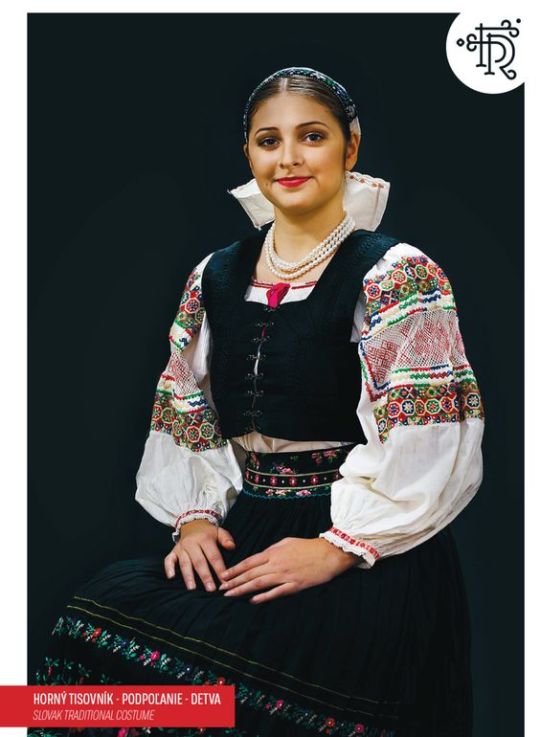
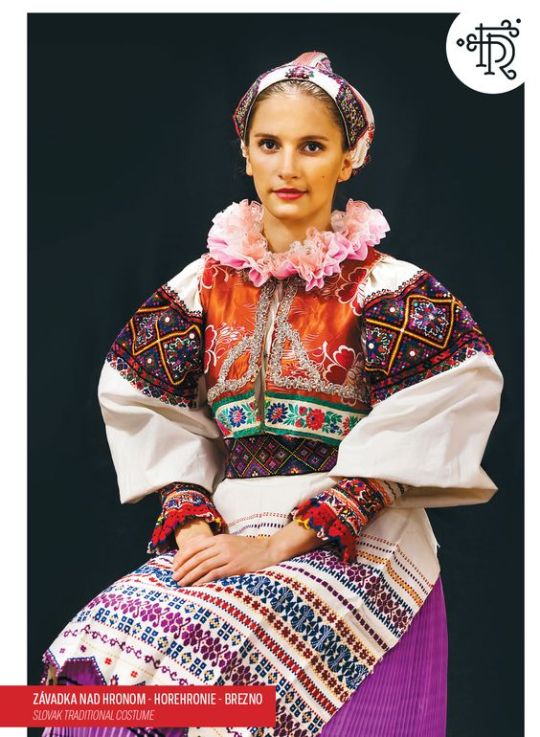
Slovak Folk Costumes
#slovak#slovakia#folk costumes#traditional clothing#ethnic#slovaks#carpathian#eastern europe#central eastern europe
67 notes
·
View notes
Text
fascinating how quickly westerners will forget about eastern europe and central asia and the amount of genocides that had occured there under the communist rule. truly baffling. you wouldn't be a trans gay baddie with a red flag in your bio bestie you'd be a corpse.
366 notes
·
View notes
Text








przedświąteczne Katowice, błoto, wiatr i modlitwa o koniec szarówy
#polishposting#poland#polishcore#polish tumblr#eastern europe#east europe#ulica#doomer#slavic#polblr#central europe#silesia#polish wave#katowice
110 notes
·
View notes
Text
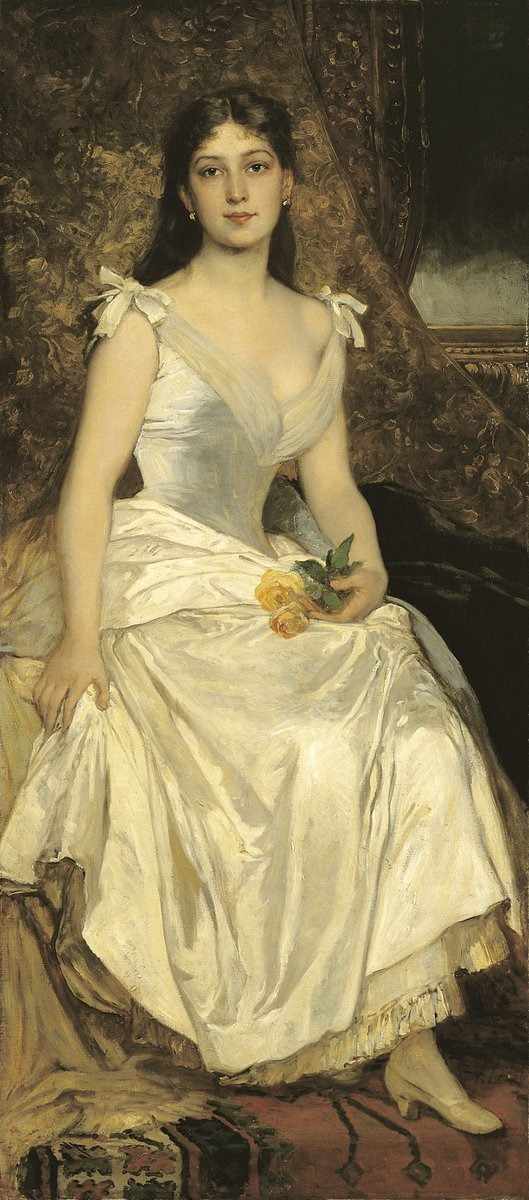
Károly Lotz (German-Hungarian, 1833-1904) Ilona Lotz in White, ca.1880s Hungarian National Gallery
#Karoly Lotz#German#hungarian#art#1800s#fine art#european art#classical art#brunette#woman#female portrait#female#portrait#europe#european#oil painting#fine arts#europa#ilona lotz#ilona lotz in white#hungary#eastern europe#central europe#classic art#traditional art#regency
1K notes
·
View notes
Text

YESS!! Yesss! The new world is so me, I was literally screaming when I saw it! I have so many ideas, and getting tons of new ones just by looking at the trailer!!!
Once I get my hands on that EP, nobody can stop me ahhaha🔥🔥🔥
#interacting with people#i know it was based on transylvania#but it can actually pass for any bigger central/eastern european cities#i think i live in central eu but once i cross the danube it is eastern europe#and i live very close to the Danube#i go to uni in central europe and every time i need to eat my fave dürüm at Kálvin Kebab i need to travel to eastern europe#best gyros in BP so if you're travelling to Hungary pls eat a dürüm at Kálvin Kebab in Kálvin Square
74 notes
·
View notes
Text

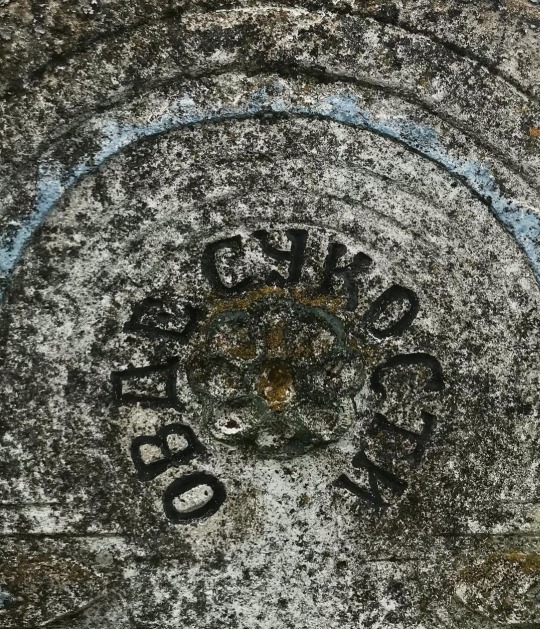
"овде су кости - here are the bones" graveyard in a village borač, vicinity of knić, serbia.
#graveyard#cemetery#serbia#slavic#balkan#eastern europe#orthodoxy#eastern orthodox#knic#borač#kragujevac#sumadija#central serbia
332 notes
·
View notes
Text

has this been done already
#ky speaks#I've spent the last two months in central/eastern europe#rn I'm in Italy#and this is a HUGE mood#the cathedrals are absolutely gorgeous#stunning#but.... catholicism
61 notes
·
View notes
Text
unrelated to the stupid stuff today but i really like the headcanon of medic being jewish + given this part from genius...maybe. maybe he is

#i heard about this earlier today but i was *really* hesitant to include it bc i didnt see the genius page until like a few hours ago#+ apparently he said “danke” in a distinctly Yiddish way#but i havent heard yiddish in my personal life so i wasnt too confident on that either.#regardless - a very interesting aspect of him to think about (positive)#but this makes the “medic is a nazi!” thing even more offensive and dumb because this song was reminiscent of jewish music#(specifically klezmer being a instrumental musical tradition for Ashkenazi jews in central/eastern europe)#idk how anyone would be so confident to call him something like this D:<#sorry for the complaining guys. but damn its annoying#f/o blog#tf2 medic#[just me yapping]#proships dni#ok to rb#💉🫀
29 notes
·
View notes
Text




Did this doodles a while ago, literally last week, they are Poland (glasses and headband), Croatia (The one with the tie), Ukraine (the one posing) and Belarus (The one with the scarf)
#aph#central europe#europe#oc#poland#slavic#hetalia#hetalia aph#aph poland#hetalia oc#hetalia poland#country oc#art#countryhumans#countryhumans poland#balkans#croatia#aph croatia#hetalia croatia#countryhumans croatia#original character#characterdesign#belarus#aph belarus#hetalia belarus#countryhumans art#countryhumans belarus#eastern europe#the nation chronicles#TNC
30 notes
·
View notes
Text

Inside a house in Zalipie, Poland
#Poland#Central Europe#Eastern Europe#Slav#Slavic#Cute#Folk#Folk art#Beautiful#Europe#Room goals#Traditional
141 notes
·
View notes
Text



if a cherry vodka shop looked like a 70s sci-fi spaceship // kraków, poland // april 2024 // ©
#my photos#original photographers#photographers on tumblr#travel#europe#photography#photooftheday#poland#vodka#krakow#sci fi#kraków#eastern europe#central europe#eu#orange#color photography
33 notes
·
View notes
Text
TIL from a podcast featuring historian and Byzantine archaeologist Yannis Theoharis:
Athens was one of the most religiously conservative cities of the Byzantine Empire. It adhered to the ancient Greek religion for longer than most other areas. Contrary to popular belief, its eventual conversion to Christianity did not happen violently. Christianity was getting more and more ground amongst the believers progressively. Meanwhile, the ancient temples and shrines were progressively emptying but as long as there were believers they were functioning properly and had guards and went through restoration works and all, as stated by Neoplatonic philosopher Proklos (with the exception of nude sculptures which had been destroyed already by proto-Christians). The historian also claims the conversion of the temples to churches happened later than what was previously believed, around the 7th-9th centuries. As the vast majority of the population had eventually converted to Christianity, the temples were left abandoned. The empire ordered their conversion to churches so that funding their preservation could be justified. Furthermore, there wasn’t as much of violent banning of ancient schools as it was thought. Justinian did not ban the function of the Neoplatonic school in Athens but ceased the state funding unless the school accepted to add Christian theology to its curriculum. The Neoplatonic school refused but it was not banned. It kept functioning using its own private funds until this wasn’t enough and the school had to close. Evidence for this is that it is documented that the school functioned for several decades or more than a century (don’t remember exactly) after Justinian’s imperial command, which was previously viewed as an immediate or violent shutdown. Meanwhile, the Neoplatonic school in Alexandria (in Egypt) agreed to add Christian theology to its curriculum and it kept functioning undisturbed until the 7th century and the Arab conquest.
Also, he has more insight into the similarities observed between Eastern / Greek and even all Orthodoxy and the Ancient Greek religion, such as idol / icon worship, lesser deity / saint worship, virgin female deity / super saint worship, patron gods / saints etc He says there was an interesting cycle of Christianised Hellenism followed by Hellenized Christianity. Some of these elements of Christian Orthodoxy were emphasized more than in the early years of Proto-Christianity or even exaggerated by the Byzantine Greek Christians in order to attract the pagan Greeks and make them understand more easily the philosophy of the new religion and find common ground between them. It worked.
Lastly, he disputed the dated assumptions that the Visigoth king Alaric I was assisted by monks to destroy Athens during his invasion in 396. This was falsely concluded because in documents it was found that Alaric was accompanied by men clad in black. Theoharis says these were actually Thracian soldiers (Alaric indeed fared long in Thrace and the Thracians were by large mercenaries) and supports it is very unlikely based on historical evidence of the time that Athenian or Greek Christians would collaborate with a Visigoth invader to help him destroy historical areas of Athens, even if they were pagan.
These are the most important bits from memory, I am linking the podcast here, it is in Greek.
#Greece#Europe#history#Greek history#Byzantine history#Christian orthodoxy#Ancient Greek religion#Greek orthodoxy#Eastern Orthodoxy#Byzantine empire#eastern Roman Empire#justinian#Alaric I#proklos#neoplatonism#Athens#attica#central Greece#Sterea Hellas#mainland
100 notes
·
View notes
Text










ziemia obiecana była nam dana
#polishposting#poland#polishcore#eastern europe#polish tumblr#east europe#ulica#slavic#autumn#napisy#polska#łódź#boat city#central europe
143 notes
·
View notes
Text
Maria Skłodowska-Curie
Not Marie Curie. Maria Skłodowska-Curie.
Isn't it ironic that she is called a "feminist icon" in Beetlejuice Beetlejuice, and at the same time her deliberate choice to use her Polish name is not respected? And of course they called her "French" in the movie. Because it's so hard to grasp that she was Polish and just married a French man. And she literally called Polonium after Poland.
It's especially annoying because Poland experienced cultural erasure. Maria was born when Poland wasn't on the maps, and Poles lived under Russian, German and Austrian partitions for 123 years. Same goes for Fryderyk Chopin, who also was born at the occupied Polish territory (to a Polish mother and French father).
Calling Maria Skłodowska-Curie "Marie Curie" is lazy, incorrect and disrespectful, as it erases her identity both as a woman and as a Polish person. It's also a part of a bigger issue of people from the West looking down upon people from the East (some people say Poland is in the Eastern Europe, some say it's in the Central Europe, and as far as I'm concerned, both takes can be defended, but I'm using here the term "East" to include everyone who faces this problem). So yes, there is also some xenophobia in here.
Tl;dr Call this woman her correct name, lazy dumbasses.
#maria skłodowska curie#beetlejuice#beetlejuice beetlejuice#tim burton#jenna ortega#slavic#eastern europe#central europe#feminism#fryderyk chopin#history#cultural erasure#poland
28 notes
·
View notes
Note
Could you share with us some traditional Central European farm house inspirations ? :D
This guide is about Hungarian traditional farmhouses.
🏠 EXTERIOR & STRUCTURE
Back in the 19th century, the three-room farmhouse was a common sight all across the Carpathian Basin. Its rooms are arranged in rows, i.e. one after the other. The front of the house, facing the street, was shorter, and you could enter through the long courtyard. The room facing the street was usually the main living area, while the second room served as the kitchen. In simpler houses, the third room was a pantry, but it wasn't uncommon to find a second room or even multiple pantries.
The floor was usually made of brick or tiled earth.
In richer houses, rooms had wooden floors.
The walls were white or smoky

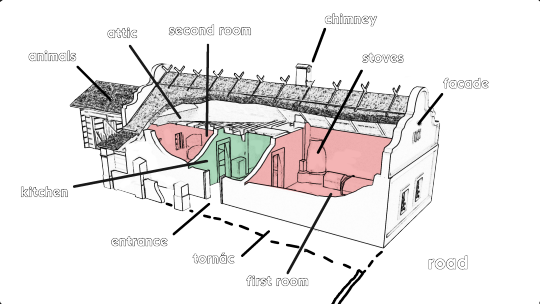
🚪 ENTRANCE / Bejárat
It has two types: (1) There is only one external entrance from the courtyard, the other rooms can only be accessed via this entrance. It always leads to the second room. (2) Each room of the house has a separate entrance to the courtyard, and there is no internal passage between them.
🏛️ TORNÁC / PORTICO?
The wooden side-tornác is generally older, but there are many variations depending on the region.
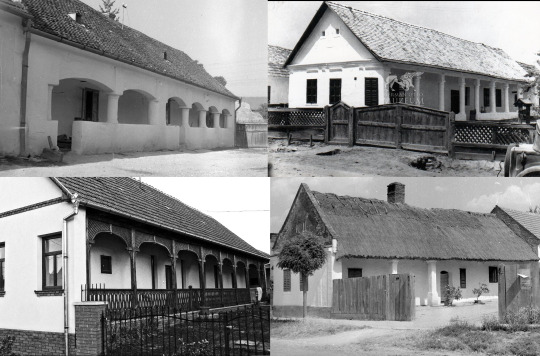
🏛️ FACADE / Oromzat
The façade varied from landscape to landscape and from house to house. The houses were richly decorated with floral, religious and national motifs.
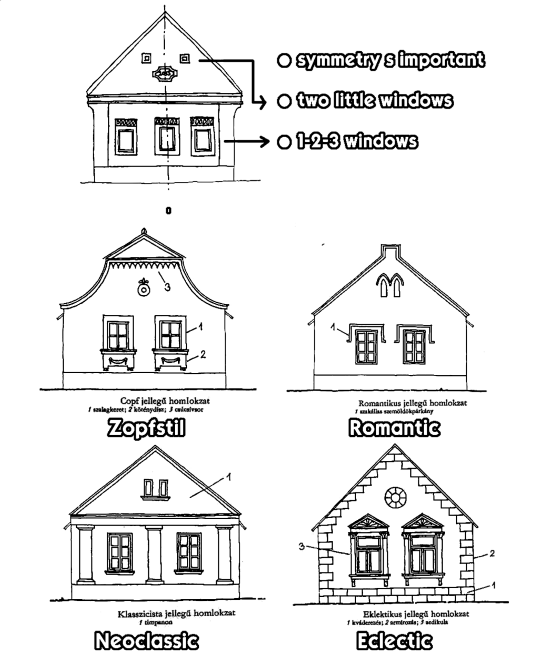

Traditional houses at Balaton.
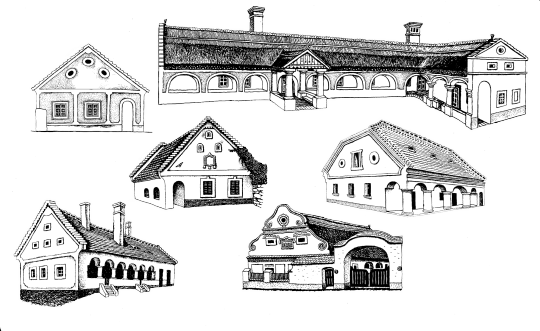
🐔 THE COURTYARD / Udvar
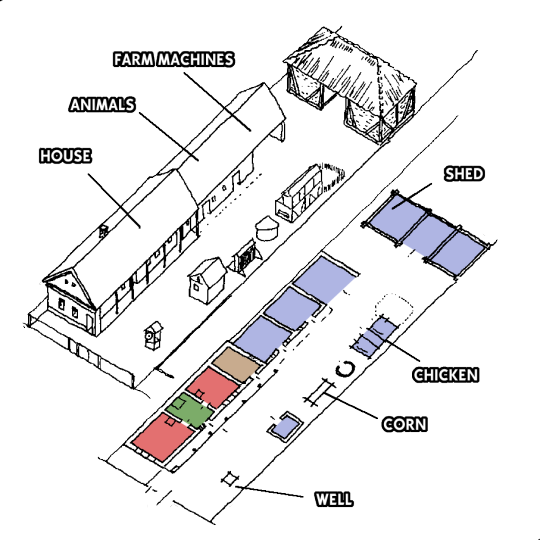
🔥 STOVE / Kályha & Tűzhely
In the village house, the stove takes center stage and symbolizes the heart of the home. The kitchen had a fire burning to cook meals, and the warmth spread throughout the house thanks to a closed stove in the adjacent room. So, not only did the kitchen provide delicious food, but it also kept the entire house cozy and snug.


🔪🍰 KITCHEN / Konyha
Old traditional Hungarian kitchens were known for their functional design, centered around a hearth for cooking and a sturdy wooden table for family gatherings. These kitchens were often decorated with handmade ceramic or copper utensils, giving them a charming traditional touch.
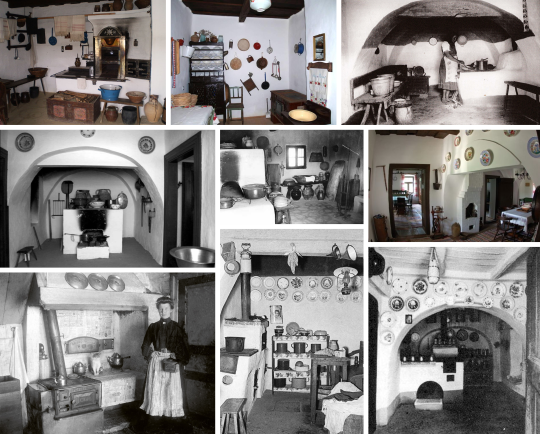
🛌💤 ROOM / Szoba
Interestingly, in many areas, the first room wasn't used much at all, except for specific occasions like when someone was sick or when there was a baby on the way. The room was beautifully adorned and one corner was set up as an altar. People referred to it as the "clean room" because it was kept tidy and pristine.

LINKS & MORE EXAMPLES
Traditional farmhouse exterior: [omnia]
Hungarian villages: [fortepan]
Traditional floor plans & rooms: [mek.oszk]
Floor plans, motifs, exterior, furniture [arcanum]
Floor plans, exterior, roofs, regional differences [docplayer]
Interior of a house from 1863 [szikm.hu]
200 years old house interior & exterior [24.hu]
Pretty houses [multidezoepiteszet.blog.hu]
Wooden deco elements and more pics [mandadb.hu]
Useful link for every aspects of a farmhouse [sulinet.hu]
Houses from Kalotaszeg, a village in Transilvania [taj-kert.blog.hu]
The architectural tradition of the Hungarian village [epiteszforum]
more, and more... [mandadb.hu]
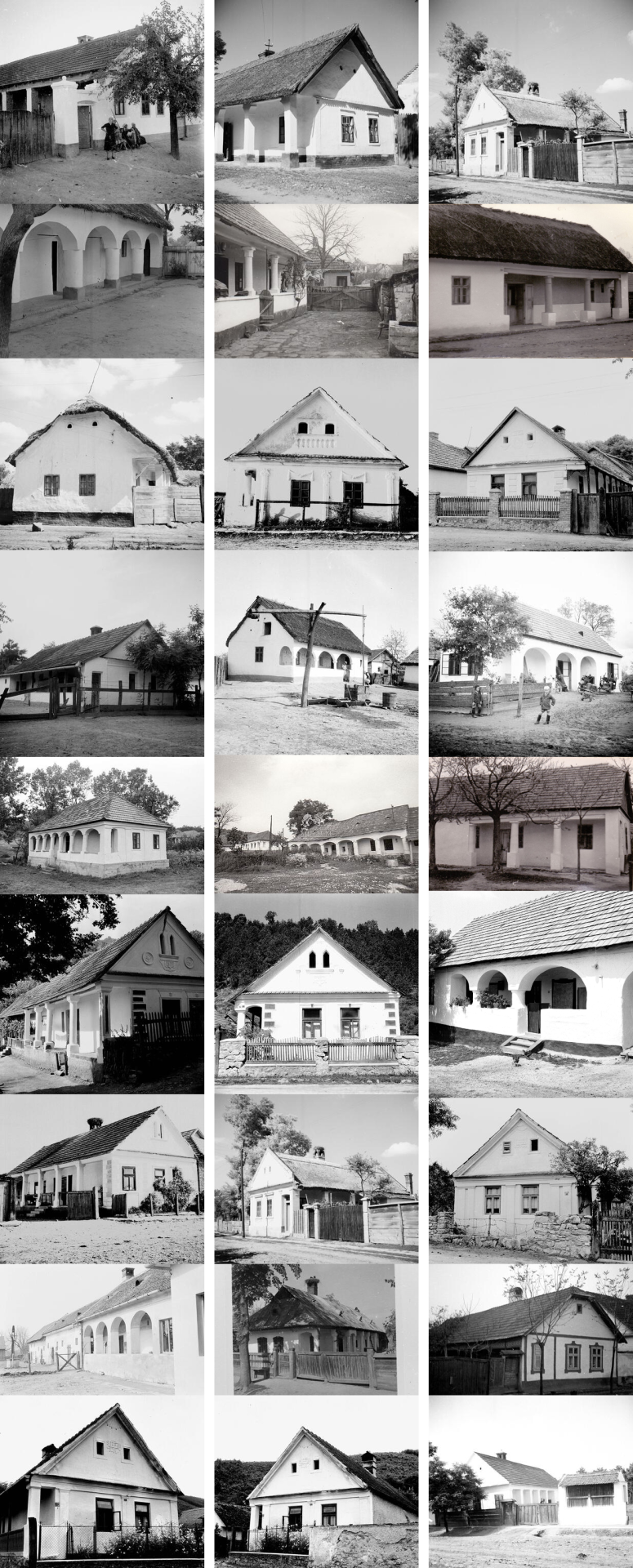
#guide#hungary#hungarian culture#european culture#central europe#eastern europe#Btw I'm from a schwabian (german minority in Hungary) town and I went to german minority schools so what I know is mainly schwabian culure
460 notes
·
View notes
Text
Since a lot of people seemed to like the photos yesterday, I've spent a good chunk of today trying to find a good contemporary photo or drawing of a stagecoach from even remotely the right period or part of Europe. And I'm sorry to say I've failed.
What I have found is this coach, currently on display in Switzerland, which is at least approximately the sort of thing that just showed up for Jonathan:
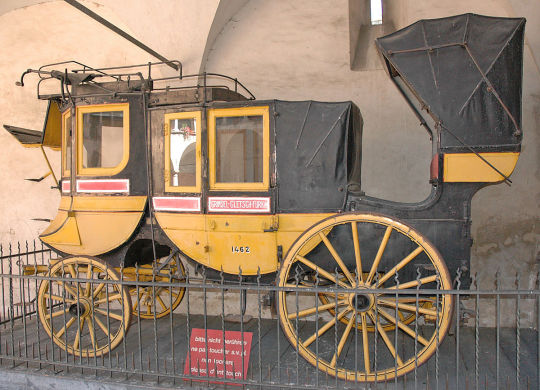
(I hope any stagecoach nerds won't mind too much that I've shared something from the wrong country and decade but it's the best I could do).
And this one's from Denmark circa 1850, which you'll notice is also the wrong country and decade. But it is picturesque, so I feel like our friend Jonathan would forgive me:

#dracula daily#may 4#there are heaps of earlier european stagecoaches#and heaps of contemporary and later american stagecoaches#but no contemporary stagecoach photos or paintings from central or eastern europe that i've been able to find
290 notes
·
View notes